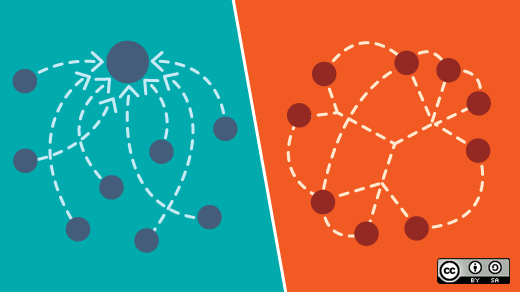Organizations of all kinds have long struggled to accurately measure the performance of individual members. The typical approach is to assess an individual's performance against a metric usually tied to whether or not they performed a task and the amount of output they generated by doing so. There's a lot riding on these assessments: everything from compensation increases and bonus payments to promotions. And as anyone who has ever given or received a traditional performance review knows, this process can be highly subjective—even in the most metrics-obsessed organizations.
But what about the kinds of jobs where measuring someone's "output" isn't about counting the number of widgets they produced, but rather it's about how they managed a team or influenced others or helped people collaborate better? While it might be easy to measure someone's output on an assembly line, how do we decide how well a manager manages or a leader leads?
In the case of an organization like Red Hat (the organization where I am the CEO) which operates as part of multiple open source software communities like Linux and OpenStack, these questions are all the more difficult to answer—like how to measure someone's contribution to an external community—and traditional performance reviews just don't cut it for us. For example, building open source software, like we do at Red Hat, involves collaborating with people outside of the company who volunteer their efforts. That means you can't simply issue orders or direct what work gets done and when. What you can do is build influence and trust with other members of the community. But doing that can involve making contributions that offer no direct output or result. It's not quid pro quo, and it's not easy to track and measure.
Conventional performance reviews can also undermine a company's agility and lead to missed opportunities. What happens when an individual's goals no longer make sense, because the competitive landscape has changed, but their performance rating (and by extension, their compensation and advancement opportunities) are all resting on the completion of those goals? That's not a system that promotes innovation.
How do you even begin to appraise someone's performance in these scenarios?
That's why at Red Hat we've developed a simpler, more flexible approach to performance reviews, one that doesn't limit us to narrow measures of performance.
First, we've found that it's essential to make sure that associates and their managers are on the same page when it comes to the responsibilities and expectations for the role. We expect people to track what's important and to set individual goals that contribute to our company's mission and strategy. We encourage a regular check-in process to make sure that managers and associates are in sync. However, we've found it best to let managers and associates determine the frequency of those. Some take place weekly, others happen on a monthly or quarterly basis.
Second, managers focus on opportunities, not score-keeping. Our associates are incredibly talented, passionate people. We don't want them to fixate on a number or letter grade, so we don't hand them a bottom-line score to sum up last year's performance. Instead, we focus on developing their strengths and growing their capabilities. We advise managers to give continuous, real-time feedback throughout the year, and use the annual review as an opportunity to reflect back on everything they've achieved, what they've learned along the way, and what opportunities they will pursue in the coming months. Unlike many companies, we don't expect our managers to fit people to a bell curve with a maximum number of low and high performers. Instead, we tell them to pay attention to both performance and potential, and to focus on connecting their people with opportunities for growth and development.
We also rely on associates' peers and communities to informally assess how people perform. We pay attention to their reputations and how they are regarded by others. We look at the scope and quality of their influence. The result is that rather than "managing up" to their boss to get a good review, Red Hatters are accountable to the community as a whole.
Finally, when it comes to promotions, raises, and bonuses, we don't force managers to apply a merit matrix or rigid formula. Instead, we give them the flexibility to make decisions that are right for their people. This means our managers don't have to enter inaccurate ratings to "game the system," a problem faced by many other companies.
The conventional way to reward top performers is to promote them into managerial roles. This often creates an army of ineffective and unengaged managers. But we have come to embrace the concept of a "career of achievement" in addition to a "career of advancement." Some of the most influential leaders in our organization do not have fancy titles or even people who directly report to them. They are expert individual contributors who help shape the direction and priorities of Red Hat and key open source communities through their contributions and thought leadership.
A great example is Máirín Duffy, one of our user interface designers. Máirín started working at Red Hat as an intern and later joined us full time in 2004, after she graduated from college. While Máirín has made exceptional contributions to our core Red Hat Enterprise Linux product, she has also earned a stellar reputation throughout the company (as well as open source communities) for her reasoned and intelligent contributions to mailing list conversations on everything from the creation of Red Hat's mission statement to contentious internal debates.
It was in a case involving the latter that led Red Hat's executive vice president and chief people officer DeLisa Alexander to approach Máirín to talk about a proposed project. In other words, a senior leader in the company went directly to someone working closer to the front lines to gather feedback on a fairly major corporate-wide decision, simply because DeLisa, the executive, knew that Máirín, the user-interface designer, could help make or break the success of the final decision based on her level of influence throughout the company.
A traditional performance review rating could never capture the kind of influence Máirín has built inside our organization and the communities we participate in. Even a 360-degree review from her immediate peers or manager wouldn't reach far enough to show Máirín's impact. Everyone at Red Hat knows who Máirín is, because her contributions shape many areas of the company.
If your performance review system prevents your managers from recognizing and rewarding people like Máirín—or discourages your associates from pursuing innovative ideas—maybe it's time for a reboot.
Originally published by Harvard Business Review. All rights reserved.





1 Comment